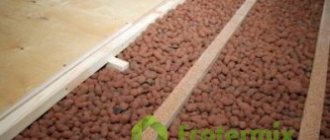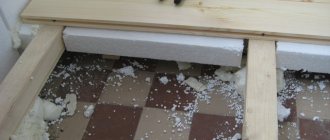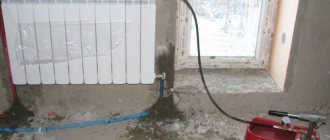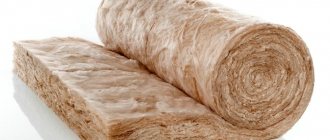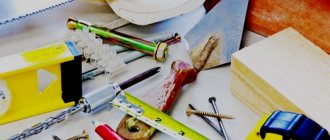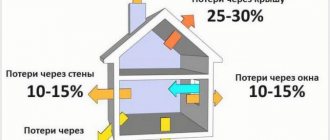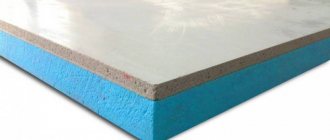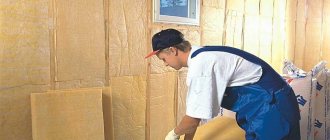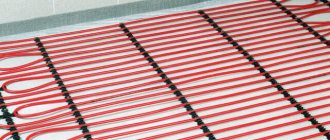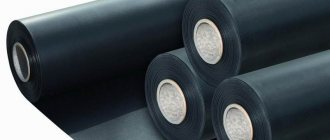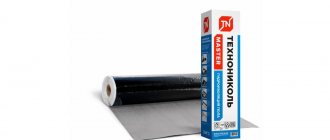Analysis of the causes of noise in the apartment
Planning soundproofing in an apartment/house begins with the causes of discomfort, as well as your own needs. The usual soundproofing of the floor in the apartment will help against noisy neighbors below, but the roar from playing a powerful audio system will have to be “hidden” under comprehensive sound insulation.
There is no way to completely get rid of extraneous sounds in an apartment; you will still hear them. It is impossible to get rid of the impact noise of the neighbor's hammer drill using floor sound insulation; it can only be reduced.
Types of sound insulators and installation methods
Not all types of sound insulation are suitable for a particular apartment. Thus, a noise-absorbing system made using wooden lathing requires high ceilings in the room. Its level is 5 cm, plus the thickness of the plywood on top. As a result, the ceiling will become lower and the parameters of the room will decrease. In this case, modern materials are chosen for soundproofing floors in an apartment with a small thickness but good sound insulation.
The market is overflowing with soundproofing raw materials, and choosing the right one is not easy. However, there is a list of the most popular types of noise absorbers:
- expanded clay;
- stone wool;
- soundproofing;
- cork insulation;
- shumoplast;
- eco-panels;
- Isoplat;
- makes noise;
- expanded polystyrene.
Expanded clay noise insulation refers to frame insulation; it is quite in demand, since the raw material has a lot of advantages:
- very durable;
- does not ignite;
- environmentally friendly;
- resistant to attacks by mold, fungi, and pests;
- not afraid of moisture.
Cons: not used in rooms with low ceilings, causes installation difficulties.
Frameless soundproofing in apartments is not popular, as it can only absorb light noise: loud conversations, background from the TV. But its design is thinner - only 2-3 cm. The frameless version is easy to install and does not eat up space due to its location on the surface.
Mineral wool
Three types of mineral wool act as insulation and sound insulators - slag wool, glass wool and stone wool. You can buy them in slabs or rolls. All types have different densities, thermal conductivities and load effects. They also differ in their heat and moisture resistant characteristics.
Slag
Slag wool is not used in rooms with high humidity. The product is made from various blast furnace slags. It is laid between the lags of the sheathing, but it is still not recommended for residential premises.
Glass wool
Glass wool is always used in tandem with the sheathing. Its main purpose is sound and heat insulation of non-residential buildings: workshops, warehouses, storerooms. Cotton wool absorbs moisture and is therefore unsuitable for use in damp areas. It is not suitable for exterior finishing work for the same reason.
Stone wool
This wool can withstand temperatures up to +550°C and is based on molten rocks. For example, MaxForte EKOplit 110 are basalt acoustic elements held together with safe PVA glue. The material does not contain formaldehyde resins, is considered high-density, and is used without lathing. Copes well with impact noise.
Floating floor
This type of floor has nothing to do with interaction with water; it received its name due to the absence of decorative finishing compounds on the surface. When laying flooring or parquet boards on joists, do not use nails, glue, or screws. Despite this, such a floor is an excellent sound insulator.
We recommend: From A to Z: all materials and methods of soundproofing an apartment
Cork sound insulation
Cork is an excellent decorative sound insulator; it is laid using laminate technology. It is used to make a substrate - a flooring for any floor covering. Cork perfectly absorbs noise and reflects extraneous sounds from the outside. For example, a 2 cm thick cork material protects against loud sounds in the same way as a 10 cm thick concrete wall.
Cork is sold in the form of slabs, rolls, and panels. It can be used with or without a cork backing. The material has a lot of advantages:
- keeps the room warm;
- environmentally friendly;
- "breathes";
- easy to install;
- eliminates noise at low thickness.
Cons: ignites quickly, is affected by pests, has a high price.
1 sq. m of cork insulation with a layer of 1 cm costs approximately 650 rubles. The price of laying the coating starts from 100 rubles. per square.
Other materials
Less popular sound insulators are soundproofing, expanded polystyrene, shumoplast, shumane.
- Sound insulation is a product made from two-layer bitumen-polymer raw materials, sold in rolls. Easy to install, has excellent hydro- and sound-proofing properties, and can be laid under all types of floor coverings. Minus – high price: 1 sq. m costs 570 rubles.
- Expanded polystyrene is resistant to moisture, weighs little, is cheap, and easy to install. Disadvantages - fragile, quickly flares up from fire. 1 sq. m of extruded polystyrene foam 5 cm thick costs 260 rubles.
- Shumoplast - polymer granules for soundproofing concrete floors. Based on rubber, polystyrene foam, acrylic compounds. For complete sound insulation, a layer of 2 cm is enough. Cons: long wait for complete polymerization - about 2 days, more suitable for floors with floating screed.
- Schumanet is a mineral acoustic slab. It has high density and thermal conductivity, is non-flammable, and is used in damp rooms. Price per 1 sq. m — 260 rub.
Traditional methods of soundproofing floors
Carpeting has long been used in many homes to muffle sound, then the now popular carpet on various bases appeared. This “soft floor” will help “remove” the echo and absorb sounds coming from outside. Its advantages: ease of use and low loss of room height. But this option is less effective than installing permanent layers. External coatings wear out quickly and require frequent replacement and constant maintenance.
Progress dictates its own rules: additional protection is possible even at the stage of creating the floor.
The most common types of sound insulation are:
- “Floating” modification with concrete covering. Such sound insulation under a floor screed will be budget-friendly and an excellent basis for consumers who expect additional strength or thermal conductivity (for example, when installing a water-heated floor).
- The presence of gaskets if the final coating is laminate, hard linoleum, hard parquet.
Innovative “floating” floors without connection to the base and top layer. It is also possible to purchase panels of a special design for effective soundproofing of the floor screed: between layers of durable cardboard there are honeycombs with finely dispersed quartz. Thanks to this thoughtful composition, the sound dissipates and fades away. Also interesting is the Shumoplast mixture with rapid polymerization.
For wooden floors or when using plasterboard, laminate, chipboard, it is possible to use a soundproofing layer of cork backing or a thin insulating membrane.
Sound insulation by base type
When choosing sound insulation, you should take into account not only the final floor covering, but also the type of base on which the insulation will be laid. This affects the flooring design and future use of the floor.
Wooden logs
Wooden logs serve as a kind of frame for laying sheet, roll and tile coverings. In addition to them, the design uses hydro- and vapor barrier, plywood and finishing. The logs, under which there are a couple of layers of acoustic “cushion”, are attached to the walls using vibration-damping supports. The perimeter of the room is fixed with damper tape.
The plywood sheets placed on top of the joists are secured with acoustic sealant. The seams of the second layer should be placed so that they are offset relative to the joints of the first. Then the finishing is done. Pros of the scheme:
- quick installation;
- replacement of individual elements if necessary;
- flat final base.
Unfortunately, this option is not suitable for heated floors.
Concrete wet or semi-dry screed
Wet screed is the process of filling the base with a cement composition. Usually this is a sand-concrete composition used in almost all areas of construction. Wet screed has many advantages:
- used for wet areas;
- high strength;
- used as a finishing coating for coatings.
Flaws:
- long-term shrinkage - about a month;
- tendency to cracking;
- load on the base due to heavy weight;
- the need for further leveling using special mixtures;
- preliminary laying of reinforcing mesh.
Semi-dry screed is a loose mixture of sand and cement, including additives and plasticizers. It is mixed and supplied to the room using special pneumatic blowers. The finished area is treated with a trowel-grinding device. After grouting, to avoid cracking, holes are made across the entire surface of the floor to a depth of 1/3 of the total thickness of the screed layer.
Before decorative finishing, these seams are masked with sealant. They can be reinforced with metal corners - this will allow the floor to withstand heavy loads and not crack.
You can use the floor, as well as lay a decorative covering on it, or make sound insulation 12 hours after installation.
Dry screed
Drywall, OSB, gypsum fiber sheets, and plywood are used as dry screeds. The raw materials are laid in 2 layers, each secured with special glue. The joints are carefully fixed, which significantly reduces the penetration of sounds. If necessary, the resulting area is puttied and covered with waterproofing mastic. Then the finishing coating is applied.
We recommend: Doing your own balcony soundproofing
Modern soundproofing materials
There is a huge range of soundproofing materials available on the modern market. They all differ in technical characteristics, scope of application, thickness, ease of installation, and cost. The most common materials are:
- Shumoplast;
- TecSound;
- Isoplaat;
- stone wool;
- Soundproofing;
- Soundproofing
All of the above materials have their advantages, which we will consider below in more detail.
Shumoplast is an innovative material that effectively insulates impact noise. It consists of a granular mixture with polystyrene foam, acrylic and rubber components. Used for sound insulation under screed in floating floor construction. This mixture has been specially developed for use on large areas and floors with uneven surfaces. With the help of Shumoplast, the optimal acoustic characteristics of noise-insulating structures are maintained.
Teksound is a highly durable, elastic, self-adhesive soundproofing material. Teksound is used to isolate airborne noise. Its advantages include:
- high level of sound insulation due to the flexibility and elasticity of the material;
- reduction of airborne noise;
- ease and simplicity of installation;
- wide range of applications;
- frost resistance;
- fire safety.
This material is safe. It adheres firmly to various types of surfaces. It does not form mold or fungi, it does not absorb moisture and has a long service life.
Teksound is used for soundproofing floating floors, damping impact noise and soundproofing vertical partitions and ceilings from airborne noise.
Isoplaat is a fibreboard made from coniferous wood chips. This material is environmentally friendly. It does not emit harmful toxins and does not harm human health. It can be used in residential areas.
Article on the topic: Green Board fiberboard panels for sound insulation and construction
Thanks to its porous structure, the material has excellent sound and heat insulation qualities. Its advantages include:
- moisture resistance;
- low thermal conductivity;
- vapor permeability;
- high ability to absorb noise;
- fire resistance;
- long service life (more than half a century).
Stone wool is considered the most common material. Its main components are rocks of mountain origin. The advantages of stone wool include:
- good sound insulation;
- low thermal conductivity;
- fire safety;
- vapor permeability;
- environmental friendliness;
- resistance to rotting and the formation of mold and fungi.
Sound insulation is used in floating floor structures. It is used as a sound, heat and waterproofing material. One can add to its positive qualities:
- good acoustic and thermal insulation properties;
- flexibility and elasticity;
- resistance to negative factors;
- durability;
- waterproof.
Shumoizol is used to effectively protect floors from vibrations, structural or impact noise. This material has:
- high elasticity - due to the addition of plasticizers;
- resistance to high temperatures;
- waterproof.
Shumoizol is widely used when installing floating floors and as a substrate for laminate or parquet.
How to estimate the cost of work
The cost of sound insulation depends on its type, the area covered, and the insulation manufacturer.
| Type | Brand | Characteristics | average price |
| Membrane | Texound-70 | Width – 1.22 m, length – 5 m, thickness – 3.7 mm | 1450 rub. |
| MAXFORT-SOUNDPRO | Width – 1.4 m, length – 5 m, thickness – 12 mm | 1100 rub. | |
| Rolled | MAXFORTE SHUMOISOL | Width – 1 m, length – 10 m, thickness – 4 mm | 300 rub. |
| Vibration stack-V300 | Width – 1 m, length – up to 450 m, thickness – 3 mm | 300 rub. | |
| Slab | SCHUMANET | Width – 60 cm, length – 1.25 m, thickness – 5 cm | 260 rub. |
How much the cheapest sound insulation costs can be seen from the table. Inexpensive products include slabs and roll samples.
The budget option is Zvukoizol-M, its cost with a length of 15 m and a width of 1 m is only 190 rubles.
Preparatory work and step-by-step actions
Before installing soundproofing, inspect the walls for cracks, potholes and other defects. Repairing such damage with gypsum plaster can significantly reduce the penetration of sounds into the room.
Let's also consider how to soundproof the floor in an apartment if there are no cracks or putty does not help. In this case, a frame is built on the wall, which is covered with sound insulation and finished with plasterboard. The structure is secured using rubber layers. The sheets are not pressed tightly against the wall - they leave a gap of 4-5 mm, which is subsequently filled with silicone sealant.
Step-by-step instructions for soundproofing the floor in an apartment:
- Soundproof the ceiling and walls - sounds pass through these parts of the room, so insulating the floor alone is not enough.
- Level the floor, sweep well and wash.
- Seal the perimeter of the room with vibration-isolating pads, attaching them to “liquid nails.” The final height of the spacers should not exceed the height of the screed.
- Set the beacons according to the level.
- Lay sound insulation tightly and cover with polyethylene.
- Seal the top with a dry sand-cement screed, proportions 3 to 1.
- After filling a few centimeters of the base with the composition, place a reinforcing mesh.
- Pour another 2 cm of screed onto the mesh, then lay a layer of waterproofing.
- Level the surface along the beacons, then remove them.
- Sand the floor.
In this way, they soundproof a bathroom in an apartment; they work with floors made of wood and concrete; however, there are slight differences in the layout of their installation.
Floating floor for apartment
In order to make a soundproof floor in your apartment, you do not need to hire a construction crew. It is enough to read or ask around and find out about the characteristics of a particular substance that may be useful. There are several methods for soundproofing a floor. With their help, you can easily do everything yourself.
The most popular method is the floating floor method. For this you need the following materials:
- Vata:
- glass;
- basalt.
- Polymer foam material
Soundproofing a floor using mineral wool
How to make a floating floor:
- Seal the cracks and level the base.
- Lay down a layer of material. Particular attention should be paid to the joints. If they are poorly glued, then when you use mineral wool, moisture can get inside and this disrupts the thermal insulation.
- Above the level of the screed, a dividing layer is placed vertically along the entire perimeter, which should consist of an insulator.
- Remove everything that is unnecessary.
- Place a layer of material, cotton wool, horizontally over the entire surface of the floor. At the same time, hot pipes, if any, need to be covered with insulators.
- Apply a ball of polyethylene film.
- Install the beacons and fill the screed with cement mortar and wait until it dries.
- Lay the finishing layer of coating by making cracks near the walls. The gaps must be covered with plinth. The plinth must be attached either to the wall or to the floor. There are no options here.
Pros of a floating floor:
- high level of sound insulation;
- deprivation of mechanical attachment that can transmit sounds;
- if you use material with low thermal conductivity, you will get good thermal insulation;
- saving time and money on materials;
- does not require special equipment.
Floating floor technology
Nuances by type of apartment building
The method of insulating floors in an apartment depends on what type of noise bothers residents. This could be a child crying, playing a musical instrument, or structural noise spreading throughout the structure of the building.
Let's look at how to start soundproofing the floor in a panel house with your own hands:
- The old flooring is dismantled, cracks, holes and other defects are cleaned.
- The interior is often finished with mineral wool, filling all the cracks, cracks, and potholes.
- Cover the floor with polyethylene, install wooden logs, and lay a sound insulator between them.
- The top is filled with a concrete screed and covered with plywood or fiberboard.
- Lay a decorative layer.
To soundproof a wooden floor in an apartment, cellular, fibrous and granular materials are used. The most popular fiber option is the most environmentally friendly and has excellent sound-absorbing properties. Boards made from fiber from coniferous trees are highly valued, as they do not contain synthetic compounds.
Floor installation looks like this: mineral wool or glass wool is placed on wooden beams, then logs are placed. Boards or sheets of chipboard are laid on top, and on them there is a finishing coating of the residents’ choice.
Before purchasing soundproofing materials, it doesn’t hurt to check their quality. Often there are low-quality products that do not cope with the functions assigned to them.
Types of screeds
- "Dry" screed. Otherwise it is also called a prefabricated screed. It is a flooring made of gypsum fiber tongue-and-groove insulation boards laid on a layer of expanded clay. The “dry” screed is ready for laying the finishing floor covering immediately after its installation.
- "Wet" screed. It is a layer of concrete about 5 centimeters thick. Such a screed is poured onto the subfloor either independently or after having made a flooring of sound insulation, waterproofing, thermal insulation or a combination thereof. The disadvantage of a “wet” screed is the time required for the material to dry and the floor to be ready for finishing. For the composition to fully gain strength, it takes 11–14 days.
- “Semi-dry” screed. It differs from a “wet” screed in that instead of concrete mortar, a cement mixture with an admixture of fiber fiber and a small amount of water is used. The technology allows for quicker finishing, since the drying time of the screed is no more than 7 days.
Regardless of the chosen method, in order to ensure high-quality sound insulation of the floor under the screed, you need to achieve the effect of the so-called “floating” floor. A screed made using the “floating” floor method has no vibroacoustic connections either with the base or with the walls. The soundproofing effect is achieved by using a sound-insulating layer between the rough base and the screed, as well as an acoustic damper around the perimeter of the screed. Below we will describe the stages of work of all types of screed with the features determined by the creation of soundproofing of the floor.
